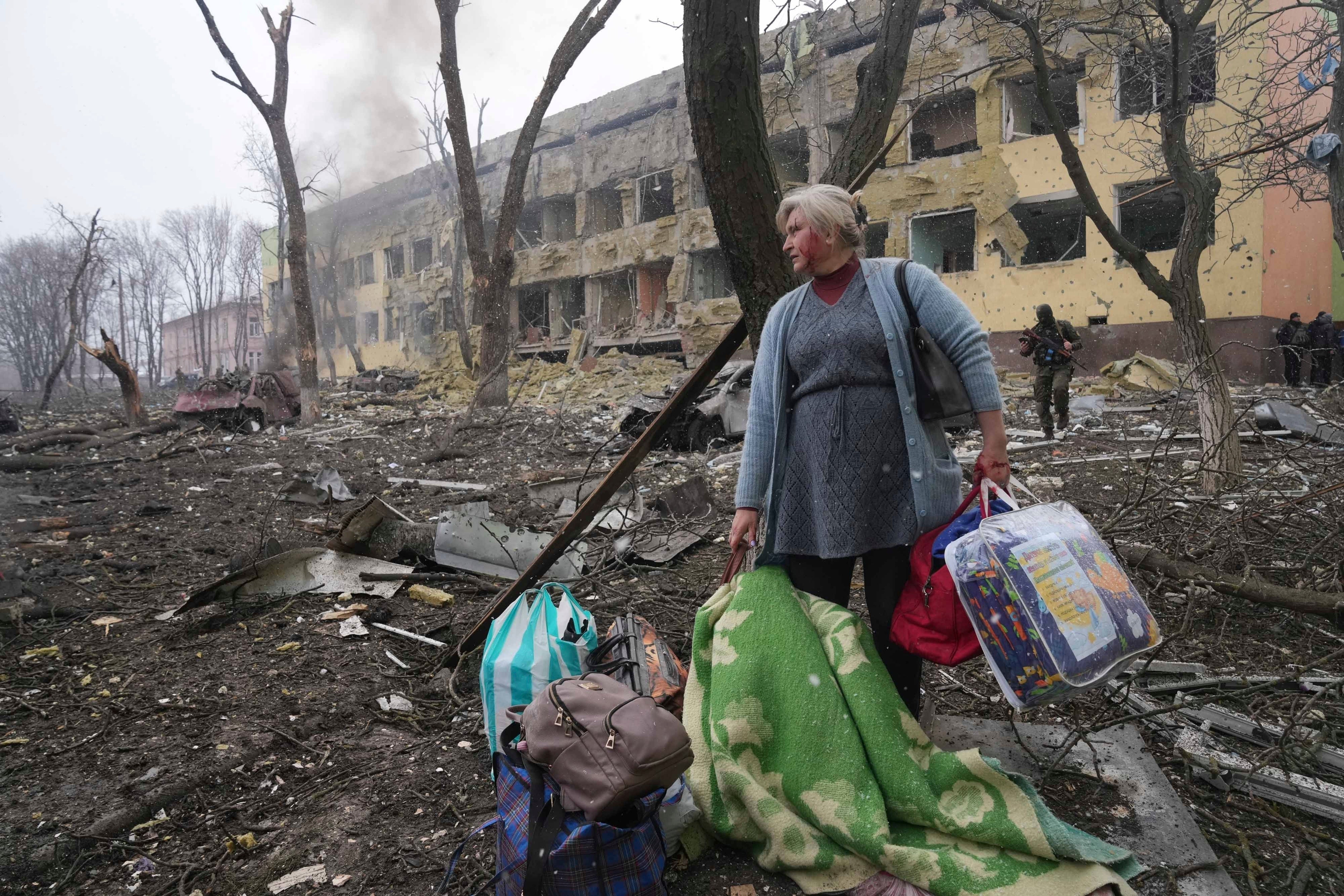The siege of Mariupol could be Putin’s template for the rest of Ukraine
Controlling Mariupol allows Russia clear passage from the Russian border to Crimea, writes Mary Dejevsky


It is, alas, a feature of military conflict that the fate of just one city comes to exemplify a whole war. In just the last 30 years you might identify the besieged cities of Sarajevo, Aleppo – and now Mariupol, a port city on the Sea of Azov in the southeast of Ukraine.
Ninety per cent of this major industrial and port city lies in ruins, say Ukrainian reports. A quarter, and probably more of the 400,000-strong population have left, and many thousands may be dead. Refugees from the city describe apocalyptic scenes, as they relate how, in the space of barely two weeks, all necessities of modern life were lost, from food to electricity to running water. The last to go was the mobile phone signal, leaving just one raised point on the edge of town where calls could be made.
The extent of the disaster may be gauged by the fact that even the Russian side has described “a terrible humanitarian catastrophe”, even as they blame it on “terror” unleashed by the other side. Ukraine had summarily rejected a proposal to surrender, with officials insisting they would fight to the end.
Which poses two big questions. What is it about Mariupol that has made it the bloodiest focus of this now month-old war? And will Mariupol become the template, is it perhaps already the model, for how Russia intends to fight from now on?
The first question is simpler to answer than the second. The chief reason why Russia is fighting so desperately to capture Mariupol is geography. For Russia, it is the key to linking up Crimea, which it annexed in 2014, with the two regions in the Donbas – Donetsk and Lugansk – that have been held by pro-Russian separatists over the same eight years.
Controlling Mariupol – or the devastated territory on which it once stood – allows Russia clear passage from the Russian border to Crimea. In wartime, this obviously simplifies deliveries of weapons and humanitarian aid. It would have the effect of making the Sea of Azov an exclusively Russian sea, rather than shared – often acrimoniously since the Soviet Union collapsed – between Russia and Ukraine.
But perhaps the greater benefit – and the original reason why Russia made the capture of Mariupol a priority – was to consolidate its hold on Crimea and improve its security and supply lines. Russia’s first move, in 2016, was to build a bridge, completed in record time, to connect Crimea to the Russian mainland. But it could only mitigate an acute water shortage on the peninsula. Securing the land corridor would mean that Russia could reconnect the water supply from the mainland, so solving a problem that bedevilled Russia’s occupation of the territory from the start.
But there are other reasons why Russia set its sights to assault Mariupol. One is vengeance. In the fighting that followed the ousting of President Yanukovych in 2014, Mariupol was captured and held by the anti-Kyiv forces, only to be recaptured after almost six weeks of fighting later in the year. An effort by the separatists to recover it failed. There are defeats here to be avenged.
Another reason is that the forces who prevailed then, and still control a part of the otherwise surrounded city, belong to the Azov Battalion. When Russians speak, as President Putin did in his declaration of war last month, about “de-Nazifying” Ukraine, the Azov Battalion is part of what they have in mind.
Begun as a volunteer paramilitary grouping and distinguished by yellow and black insignia not unlike the swastika, the group is now incorporated into Ukraine’s national guard and pledged to support President Zelensky. In common with some other erstwhile volunteer groups, however, it is seen by many as having its roots in the far-right nationalist groups that supported the German occupiers against the Red Army in the late 1930s and 1940s. The line between far-right nationalism and Ukrainian patriotism can be hard to draw.
From considerations of Russian national security to ensuring supplies to Crimea, and from avenging an eight-year-old military defeat to purging what many Russians see as dangerous Nazi tendencies, Mariupol brings together many disparate elements in the Russia-Ukraine conflict and helps to explain why both sides seem prepared to fight to the end. For Russia, control of Mariupol is a key objective of its invasion. For Ukraine, the outcome will determine not just whether it keeps access to the Azov Sea, but how much of Ukraine is left when the fighting is over.
And this links to the second question. Having effectively eviscerated a 400,000-strong port city, and trapped maybe half the population in worse than medieval conditions, is this a model that Russia is preparing to replicate elsewhere? Does Russia intend Mariupol to stand as a warning to other cities – notably Ukraine’s main port of Odesa and its capital Kyiv – if they refuse to surrender, and to Ukraine’s present leaders should they persist in their fight? Or might Mariupol remain a one-off, reflecting its location and recent history?
The answer probably depends on many factors, including Russia’s short and long-term objectives. It could be – though the scale of the initial invasion makes this unlikely – that Russia’s prime objective was always and only the corridor to Crimea. Then again, it could be that this is what Russia might now settle for, in the light of Ukrainian resistance. In that case, the capture of Mariupol might allow Russia to claim victory and end its campaign. Ukraine would justifiably oppose any territorial gains for Russia, proceeding from an illegal invasion, but that might be the price to be paid for ending the war.
If, on the other hand, Russia’s objectives are broader and its campaign is not going as badly as is often presented, then Mariupol takes on additional significance as the gateway not just to Crimea, but to Ukraine’s Black Sea coast, including its main port, Odesa, to all Ukraine east of the Dnieper river, or even to the whole of Ukraine, including Kyiv. To this extent, control of Mariupol could determine control of Ukraine.
To keep up to speed with all the latest opinions and comment sign up to our free weekly Voices newsletter by clicking here
As of now, while it is hard to detect patterns, the treatment meted out to Mariupol seems to be of a different order from anything inflicted elsewhere. Ukraine’s second city, Kharkiv, has suffered extensive damage, with emblematic buildings, including regional government headquarters, being destroyed. But the city has not changed hands and fighting appears to have died down. There is even some evidence that Russian forces are choosing to go around, rather than destroy or capture, populated areas – whether this is by choice or in response to Ukrainian resistance is hard to judge.
A related mystery might be why – for all the losses suffered by Russian forces and the difficulties in facilitating humanitarian corridors – reported Ukrainian civilian casualties remain relatively low so far. Especially given the scale of the Russian invasion. Does this reflect the effectiveness of Ukraine’s defences?
Regrettably, there will be no answers to these questions until the battle of Mariupol is decided and it becomes clear what Russia intends to do next. What can be said is that Mariupol will be the first real turning point in this war – whether it proves to be the exception or the rule.






Join our commenting forum
Join thought-provoking conversations, follow other Independent readers and see their replies
Comments